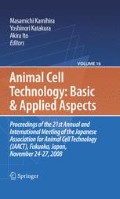Abstract
A convenient and efficient purification protocol for fetal mouse hepatoblasts and hepatocytes, which used a thermo-reversible gelation polymer (Mebiol), was established. When dispersed fetal mouse liver cells at E12.5 were cultured within the Mebiol gel, hepatoblasts rapidly aggregated into spheroids, and gave rise to hepatocytes expressing urea cycle enzymes on day 5. By contrast, nonparenchymal cells such as hepatic stellate cells and endothelial cells were dead within the gel. After culture for 3 or 5 days, fetal hepatoblast/hepatocyte aggregates could be easily separated from dead, single nonparenchymal cells by filtration. When E12.5 liver cells were cultured in a Mebiol gel containing basal laminar components, hepatoblasts gave rise to biliary epithelial cells forming cystic structures and expressing no hepatocyte marker. The culture and purification protocol for fetal liver progenitor cells may greatly contribute to regenerative medicine that aims at elucidating their growth and maturation mechanisms, and at developing novel hybrid-type artificial liver models and cell transplantation therapy.
Access this chapter
Tax calculation will be finalised at checkout
Purchases are for personal use only
References
Ikeda, T., Sawada, N., Satoh, M., and Mori, M. (1998) Induction of tyrosine aminotransferase of primary cultured rat hepatocytes depends on the organization of microtubules. J. Cell Physiol. 175: 41–49.
Nitou, M., Sugiyama, Y., Ishikawa, K., and Shiojiri, N. (2002) Purification of fetal mouse hepatoblasts by magnetic beads coated with monoclonal anti-E-cadherin antibodies and their in vitro culture. Exp. Cell Res. 279: 330–343.
Oertel, M., Menthena, A., Chen, Y., Teisner, B., Jensen, C., and Shafritz, D. (2008) Purification of fetal liver stem/progenitor cells containing all the repopulation potential for normal adult rat liver. Gastroenterology 134: 823–832.
Shiojiri, N. (1997) Development and differentiation of bile ducts in the mammalian liver. Microsc. Res. Tech. 39: 328–335.
Suzuki, A., Sekiya, S., Büscher, D., Izpisúa Belmonte, J.C., and Taniguchi, H. (2008) Tbx3 controls the fate of hepatic progenitor cells in liver development by suppressing p19ARF expression. Development 135: 1589–1595.
Tanimizu, N., Miyajima, A., and Mostov, K.E. (2007) Liver progenitor cells develop cholangiocyte-type epithelial polarity in three-dimensional culture. Mol. Cell Biol. 18: 1472–1479.
Tanimizu, N., Nishikawa, M., Saito, H., Tsujimura, T., and Miyajima, A. (2003) Isolation of hepatoblasts based on the expression of Dlk/Pref-1. J. Cell Sci. 116: 1775–1786.
Yoshioka, H., Mikami, M., Mori, Y., and Tsuchida, E. (1994) A synthetic hydrogel with thermoreversible gelation. II. Effect of added salts. J. Macromol. Sci. A31: 121–125.
Author information
Authors and Affiliations
Corresponding author
Editor information
Editors and Affiliations
Rights and permissions
Copyright information
© 2010 Springer Science+Business Media B.V.
About this paper
Cite this paper
Yori, K., Koike, T., Shiojiri, N. (2010). Purification of Hepatoblasts from Fetal Mouse Livers by Using a Temperature-Reversible Gelation Polymer and Their Application in Regenerative Medicine. In: Kamihira, M., Katakura, Y., Ito, A. (eds) Animal Cell Technology: Basic & Applied Aspects. Animal Cell Technology: Basic & Applied Aspects, vol 16. Springer, Dordrecht. https://doi.org/10.1007/978-90-481-3892-0_1
Download citation
DOI: https://doi.org/10.1007/978-90-481-3892-0_1
Published:
Publisher Name: Springer, Dordrecht
Print ISBN: 978-90-481-3891-3
Online ISBN: 978-90-481-3892-0
eBook Packages: Biomedical and Life SciencesBiomedical and Life Sciences (R0)

